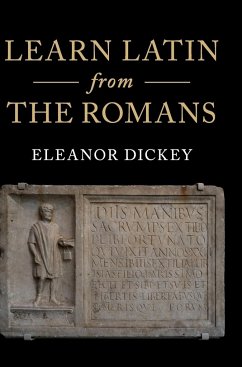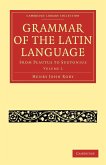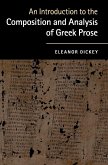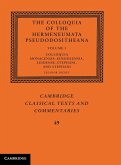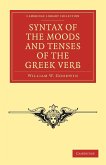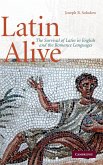Eleanor Dickey
Learn Latin from the Romans
Eleanor Dickey
Learn Latin from the Romans
- Gebundenes Buch
- Merkliste
- Auf die Merkliste
- Bewerten Bewerten
- Teilen
- Produkt teilen
- Produkterinnerung
- Produkterinnerung
The only introductory Latin textbook to use texts written by ancient Romans for Latin learners, presented in one volume.
Andere Kunden interessierten sich auch für
![Lectures On The Coinage Of The Greeks And Romans Lectures On The Coinage Of The Greeks And Romans]() Edward CardwellLectures On The Coinage Of The Greeks And Romans29,99 €
Edward CardwellLectures On The Coinage Of The Greeks And Romans29,99 €![Grammar of the Latin Language - Volume 2 Grammar of the Latin Language - Volume 2]() Henry John RobyGrammar of the Latin Language - Volume 264,99 €
Henry John RobyGrammar of the Latin Language - Volume 264,99 €![An Introduction to the Composition and Analysis of Greek Prose An Introduction to the Composition and Analysis of Greek Prose]() Eleanor DickeyAn Introduction to the Composition and Analysis of Greek Prose94,99 €
Eleanor DickeyAn Introduction to the Composition and Analysis of Greek Prose94,99 €![Latin in Church Latin in Church]() F. BrittainLatin in Church24,99 €
F. BrittainLatin in Church24,99 €![The Colloquia of the Hermeneumata Pseudodositheana The Colloquia of the Hermeneumata Pseudodositheana]() The Colloquia of the Hermeneumata Pseudodositheana172,99 €
The Colloquia of the Hermeneumata Pseudodositheana172,99 €![Syntax of the Moods and Tenses of the Greek Verb Syntax of the Moods and Tenses of the Greek Verb]() William W. GoodwinSyntax of the Moods and Tenses of the Greek Verb35,99 €
William W. GoodwinSyntax of the Moods and Tenses of the Greek Verb35,99 €![Latin Alive Latin Alive]() Joseph B. SolodowLatin Alive89,99 €
Joseph B. SolodowLatin Alive89,99 €-
-
-
The only introductory Latin textbook to use texts written by ancient Romans for Latin learners, presented in one volume.
Hinweis: Dieser Artikel kann nur an eine deutsche Lieferadresse ausgeliefert werden.
Hinweis: Dieser Artikel kann nur an eine deutsche Lieferadresse ausgeliefert werden.
Produktdetails
- Produktdetails
- Verlag: Cambridge University Press
- Seitenzahl: 532
- Erscheinungstermin: 30. Mai 2018
- Englisch
- Abmessung: 250mm x 175mm x 33mm
- Gewicht: 1087g
- ISBN-13: 9781107140844
- ISBN-10: 1107140846
- Artikelnr.: 45155212
- Herstellerkennzeichnung
- Libri GmbH
- Europaallee 1
- 36244 Bad Hersfeld
- gpsr@libri.de
- Verlag: Cambridge University Press
- Seitenzahl: 532
- Erscheinungstermin: 30. Mai 2018
- Englisch
- Abmessung: 250mm x 175mm x 33mm
- Gewicht: 1087g
- ISBN-13: 9781107140844
- ISBN-10: 1107140846
- Artikelnr.: 45155212
- Herstellerkennzeichnung
- Libri GmbH
- Europaallee 1
- 36244 Bad Hersfeld
- gpsr@libri.de
Eleanor Dickey was educated at Bryn Mawr College and the University of Oxford, has taught in Canada and the United States, and is currently Professor of Classics at the University of Reading. She is a Fellow of the British Academy and the Academia Europaea, and has published widely on the Latin and Greek languages and how they were studied in antiquity, including Greek Forms of Address (1996), Latin Forms of Address (2002), Ancient Greek Scholarship (2007), The Colloquia of the Hermeneumata Pseudodositheana (2012-15), Learning Latin the Ancient Way (2016) and An Introduction to the Composition and Analysis of Greek Prose (2016). She has extensive experience of teaching both Latin and Greek at all levels and has brought this experience to bear on her adaptations of ancient Latin-learning materials for modern students.
Preface; Introduction; The pronunciation of Latin; Part I: 1. Verbs: inflection and word order; 2. Nouns: nominative, vocative, and accusative of first and second declensions; 3. Adjectives: gender, agreement, neuters, and vocabulary format; 4. Tenses: future, perfect, and principal parts; 5. Genitive case, sum; 6. First and second conjugations, past participles; 7. Dative case, possum; 8. Second declension in -r and -ius, substantivization; 9. Ablative case, prepositions, e
; 10. Demonstratives and imperatives; 11. Reading texts; Part II: 12. Personal pronouns, partitive and objective genitives; 13. Present subjunctive, quis; 14. Third declension; 15. Subordination, imperfect subjunctive, purpose clauses; 16. Sequence of tenses; 17. Fourth and mixed conjugations; 18. Reading practice; 19. Infinitives and indirect statement; 20. Reflexives; 21. Third-declension adjectives; 22. Reading practice; Part III: 23. Demonstratives, ablative of agent; 24. Participles; 25. Relative clauses and vol
; 26. Reading practice; 27. Deponent verbs: forms from first two principal parts; 28. Indirect commands; 29. Deponent verbs: perfect-stem forms; 30. Fear clauses and long sentences; 31. Reading poetry; Part IV: 32. Passive voice, agent and means; 33. Result clauses; 34. Fourth and fifth declensions; 35. Time and place; 36. Reading practice; 37. N
l
and m
l
; 38. Regular comparison; 39. Imperfect tense; 40. Irregular comparison, negatives; 41. Gerundives; 42. Reading practice; 43. Adverbs; 44. Pluperfect and future perfect tenses; 45. Impersonal verbs; 46. Perfect and pluperfect subjunctives; 47. More subordinate clauses; 48. Reading practice; Part V: 49. Fer
; 50. Conditional clauses; 51. F
; 52. Ipse and iste; 53. Reading practice; 54. Indirect questions; 55. Numbers; 56. Relative clauses with the subjunctive; 57. Ablative absolute; 58.
dem, expressions of price and value; 59. Reading practice; 60. Gerunds I; 61. Gerunds II; Appendices: 62. How to use the appendices; 63. Further grammatical explanations and exercises; 64. Key to further exercises; 65. Alphabetical glossary of grammatical terminology; 66. The metre of Virgil's Aeneid; Cumulative vocabulary, Latin to English; Cumulative vocabulary, English to Latin; Index of grammatical topics covered; Index of Latin passages included.
; 10. Demonstratives and imperatives; 11. Reading texts; Part II: 12. Personal pronouns, partitive and objective genitives; 13. Present subjunctive, quis; 14. Third declension; 15. Subordination, imperfect subjunctive, purpose clauses; 16. Sequence of tenses; 17. Fourth and mixed conjugations; 18. Reading practice; 19. Infinitives and indirect statement; 20. Reflexives; 21. Third-declension adjectives; 22. Reading practice; Part III: 23. Demonstratives, ablative of agent; 24. Participles; 25. Relative clauses and vol
; 26. Reading practice; 27. Deponent verbs: forms from first two principal parts; 28. Indirect commands; 29. Deponent verbs: perfect-stem forms; 30. Fear clauses and long sentences; 31. Reading poetry; Part IV: 32. Passive voice, agent and means; 33. Result clauses; 34. Fourth and fifth declensions; 35. Time and place; 36. Reading practice; 37. N
l
and m
l
; 38. Regular comparison; 39. Imperfect tense; 40. Irregular comparison, negatives; 41. Gerundives; 42. Reading practice; 43. Adverbs; 44. Pluperfect and future perfect tenses; 45. Impersonal verbs; 46. Perfect and pluperfect subjunctives; 47. More subordinate clauses; 48. Reading practice; Part V: 49. Fer
; 50. Conditional clauses; 51. F
; 52. Ipse and iste; 53. Reading practice; 54. Indirect questions; 55. Numbers; 56. Relative clauses with the subjunctive; 57. Ablative absolute; 58.
dem, expressions of price and value; 59. Reading practice; 60. Gerunds I; 61. Gerunds II; Appendices: 62. How to use the appendices; 63. Further grammatical explanations and exercises; 64. Key to further exercises; 65. Alphabetical glossary of grammatical terminology; 66. The metre of Virgil's Aeneid; Cumulative vocabulary, Latin to English; Cumulative vocabulary, English to Latin; Index of grammatical topics covered; Index of Latin passages included.
Preface; Introduction; The pronunciation of Latin; Part I: 1. Verbs: inflection and word order; 2. Nouns: nominative, vocative, and accusative of first and second declensions; 3. Adjectives: gender, agreement, neuters, and vocabulary format; 4. Tenses: future, perfect, and principal parts; 5. Genitive case, sum; 6. First and second conjugations, past participles; 7. Dative case, possum; 8. Second declension in -r and -ius, substantivization; 9. Ablative case, prepositions, e
; 10. Demonstratives and imperatives; 11. Reading texts; Part II: 12. Personal pronouns, partitive and objective genitives; 13. Present subjunctive, quis; 14. Third declension; 15. Subordination, imperfect subjunctive, purpose clauses; 16. Sequence of tenses; 17. Fourth and mixed conjugations; 18. Reading practice; 19. Infinitives and indirect statement; 20. Reflexives; 21. Third-declension adjectives; 22. Reading practice; Part III: 23. Demonstratives, ablative of agent; 24. Participles; 25. Relative clauses and vol
; 26. Reading practice; 27. Deponent verbs: forms from first two principal parts; 28. Indirect commands; 29. Deponent verbs: perfect-stem forms; 30. Fear clauses and long sentences; 31. Reading poetry; Part IV: 32. Passive voice, agent and means; 33. Result clauses; 34. Fourth and fifth declensions; 35. Time and place; 36. Reading practice; 37. N
l
and m
l
; 38. Regular comparison; 39. Imperfect tense; 40. Irregular comparison, negatives; 41. Gerundives; 42. Reading practice; 43. Adverbs; 44. Pluperfect and future perfect tenses; 45. Impersonal verbs; 46. Perfect and pluperfect subjunctives; 47. More subordinate clauses; 48. Reading practice; Part V: 49. Fer
; 50. Conditional clauses; 51. F
; 52. Ipse and iste; 53. Reading practice; 54. Indirect questions; 55. Numbers; 56. Relative clauses with the subjunctive; 57. Ablative absolute; 58.
dem, expressions of price and value; 59. Reading practice; 60. Gerunds I; 61. Gerunds II; Appendices: 62. How to use the appendices; 63. Further grammatical explanations and exercises; 64. Key to further exercises; 65. Alphabetical glossary of grammatical terminology; 66. The metre of Virgil's Aeneid; Cumulative vocabulary, Latin to English; Cumulative vocabulary, English to Latin; Index of grammatical topics covered; Index of Latin passages included.
; 10. Demonstratives and imperatives; 11. Reading texts; Part II: 12. Personal pronouns, partitive and objective genitives; 13. Present subjunctive, quis; 14. Third declension; 15. Subordination, imperfect subjunctive, purpose clauses; 16. Sequence of tenses; 17. Fourth and mixed conjugations; 18. Reading practice; 19. Infinitives and indirect statement; 20. Reflexives; 21. Third-declension adjectives; 22. Reading practice; Part III: 23. Demonstratives, ablative of agent; 24. Participles; 25. Relative clauses and vol
; 26. Reading practice; 27. Deponent verbs: forms from first two principal parts; 28. Indirect commands; 29. Deponent verbs: perfect-stem forms; 30. Fear clauses and long sentences; 31. Reading poetry; Part IV: 32. Passive voice, agent and means; 33. Result clauses; 34. Fourth and fifth declensions; 35. Time and place; 36. Reading practice; 37. N
l
and m
l
; 38. Regular comparison; 39. Imperfect tense; 40. Irregular comparison, negatives; 41. Gerundives; 42. Reading practice; 43. Adverbs; 44. Pluperfect and future perfect tenses; 45. Impersonal verbs; 46. Perfect and pluperfect subjunctives; 47. More subordinate clauses; 48. Reading practice; Part V: 49. Fer
; 50. Conditional clauses; 51. F
; 52. Ipse and iste; 53. Reading practice; 54. Indirect questions; 55. Numbers; 56. Relative clauses with the subjunctive; 57. Ablative absolute; 58.
dem, expressions of price and value; 59. Reading practice; 60. Gerunds I; 61. Gerunds II; Appendices: 62. How to use the appendices; 63. Further grammatical explanations and exercises; 64. Key to further exercises; 65. Alphabetical glossary of grammatical terminology; 66. The metre of Virgil's Aeneid; Cumulative vocabulary, Latin to English; Cumulative vocabulary, English to Latin; Index of grammatical topics covered; Index of Latin passages included.

